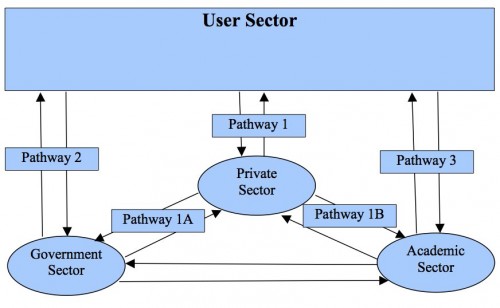The Front Page received the following note from John Nielsen-Gammon, Regents Professor of Atmospheric Sciences, Texas A&M University; Texas State Climatologist; and a Fellow of AMS:
A Message To Fellow Physical Scientists
I’m part of a new journalistic endeavor called the Climate Change National Forum and Review. The purpose of this web site will be to provide a public forum wherein scientists can discuss the latest research on climate change and share and debate ideas on aspects of climate change especially relevant to policymaking. When the second phase kicks in, policy experts will join the discussion and compare the benefits and costs of possible responses.
I know what you’re thinking: “This sounds an awful lot like the IPCC.” Well, it’s not. Nor is it intended to replace the IPCC in any way. It has a different purview and a different set of goals.
- The IPCC is an international body. The CCNFR is focused on issues facing the United States.
- The IPCC scientists are selected from nominees from various countries. The CCNFR scientists consist of anyone who contributes regularly and constructively to the discussion.
- The IPCC produces reports every few years, whose summaries are edited and ratified by political representatives. The CCNFR web site is a living document, continuously updated to account for the latest science, and not subject to political interference.
- The IPCC’s purview is anthropogenic climate change. The CCNFR’s purview is climate change in all its causes and manifestations. Would it make sense to only adapt to anthropogenic climate change?
- The IPCC reports are written by experts within their subject fields. The CCNFR will draw upon the expertise and experience of scientists from a wide range of fields, not just insiders.
- The public gets to see the IPCC final report. The public gets to see scientists grappling with, understanding, and debating the issues.
For me, this last point is an important one. The public can benefit tremendously from being able to see how scientists think and reason scientifically. We ask them to trust our collective scientific wisdom without allowing them to see how we evaluate conflicting or flawed evidence and develop judgments. Presently, the only extensive example of this available to the public is the set of emails from Climategate.
Why should you participate? First, you’ll gain a deeper understanding of climate science. Perhaps you’ve just taken the IPCC reports on faith, trusting the experts to do a good job. Whether they did or not, you will be better able to articulate the issues and explain them to others after exchanging ideas, digging into some of the primary literature, and fleshing out any questions that might be nagging you in the back of your mind.
It should be obvious by now that you don’t need to be a climate scientist to participate, as long as you have a suitable technical background. Indeed, we need at least some people who know relatively little about the state of the art of climate science, for their intellectual journey while participating in the CCNFR is similar to the journeys we hope dedicated lay readers will take. Outsiders to climate science can better spot the unspoken assumptions and unjustified conventions.
Your learning will come through the course of online debate and discussion with other scientists. As you probably know from personal experience, discussion with other scientists is often the absolute best way to come to grips with a contentious or controversial scientific issue. Along the way, you will develop skills as a writer for an outside audience.
Finally, you will be doing a public service, simultaneously helping to educate the public about climate change and about science in general.
On the negative side, it requires time, though not a whole lot. We’re only asking for participants to contribute new essays once a month, plus participate in some of the online discussions with other scientists. Compared to starting your own blog, this is a relatively easy way to bring your ideas and judgment into public view.
Scientists who think they know everything about climate change are not welcome to participate. If you’re an expert in a particular branch and want to broaden your knowledge, or even if this is something outside your expertise entirely so that you have a lot you want to learn, then come join us.
The link above that John provides is a beta form of the CCNFR web site. To facilitate your postings explaining, debating, and discussing climate science–and to keep the site tied to issues in the news and policymaking–the CCNFR hopes to provide a steady stream of news and statements culled even-handedly from the media by a professional journalist.
As such, this is not only a time to consider getting in on the ground floor of a new public outreach project but also a time to consider making a donation. The CCNFR hopes to raise more than $60,000 to get a journalist on board soon.
